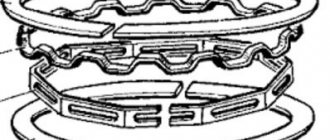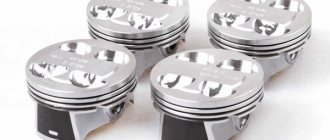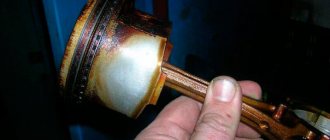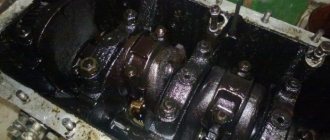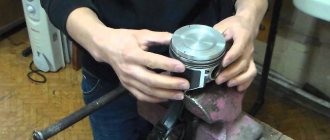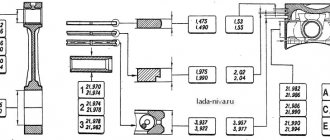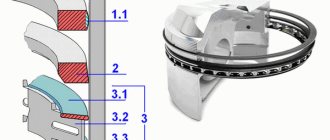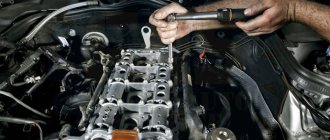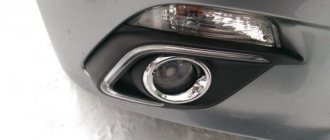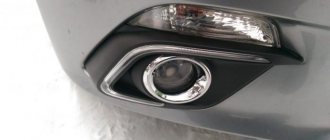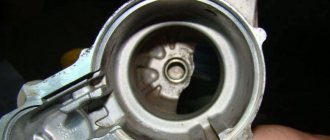As the vehicle is used, the engine gradually wears out. After several years of active driving, it begins to consume oil, problems with exhaust appear and vibration occurs at any speed. These are not good signs that indicate the presence of problems that need to be resolved as quickly as possible so as not to encounter more serious problems. One of the signs of wear is accumulated plaque on the inner walls of the cylinders and all parts. It reduces performance and degrades the quality of the engine as a whole. This condition is called coking. Let's look at the process of doing decarbonization with your own hands.
What are piston rings for?
Piston rings are necessary to create compression in the combustion chamber of the cylinder, which is a necessary condition for the operation of the air-fuel mixture during ignition.
Most often, the compression should be at least 10 “points”, but on some engine models a lower value is the norm. Combustion gases cannot pass through the gaps, since they are reliably protected by the engine's piston compression rings.
The engine also contains rings for removing excess oil from the cylinder. They are, accordingly, called oil scrapers. This ensures good lubrication in the engine cylinders and also reduces the risk of engine oil getting into the combustion chamber.
Mitsubishi Shumma Engine Conditioner
The Japanese engine decarbonizer, according to many experts and experienced drivers, demonstrates the best results. It dissolves carbon deposits or softens it, making it easy to remove mechanically.
Shumma is petroleum based, contains 20% ethylene glycol and monoethyl ether, looks like foam and smells like ammonia. This cleaner was developed for severe decoking of GDI engines (direct injection), but can be used in any type of power unit.
It is injected into the cylinders through a tube and left for at least 30 minutes (preferably 3-5 hours). The composition is not aggressive towards valve stem seals.
One Shumma cylinder is enough to clean one 1.5 liter engine. The decarbonizing agent does an excellent job of removing carbon deposits on pistons, rings, valves and combustion chamber surfaces. Can be used both for pouring into the engine without disassembling, and for soaking parts.
The price of Shumma is quite high, but justified by its performance properties. If this remedy does not produce results, we can say with confidence that only repair will help.
When to do decoking?
Decoking of oil scraper rings is necessary when the following symptoms occur:
- oil consumption increases;
- fuel consumption increases;
- engine thrust disappears;
- blue smoke appears from the exhaust pipe while the car is running;
- oil deposits appear on the air filter;
- When removing the crankcase gas recirculation hose, the car owner may notice a haze, that is, the engine is “breathing.”
If one or more of the above symptoms occur, it may often be necessary to decarbonize the engine.
Causes of coking of piston rings
Most often, car owners encounter coking due to non-compliance with engine temperature conditions. In simple terms, the motor overheats. During this, the metal of the rings weakens and becomes softer.
Oil trapped between the pistons and rings, due to the high temperature, burns both to the rings and to the piston, which is why compression decreases. Coking can also be caused by loss of elasticity of the oil reflecting caps.
This can happen due to overheating or too much mileage. Oil begins to enter the combustion chamber, which leads to coking of the rings by combustion products. One of the main reasons for coking is the low quality of motor oil, some of which enters the combustion chamber along with the air-fuel mixture.
If you use low-quality or unsuitable petroleum products, you will soon need to decarbonize the piston rings. But the problem can be prevented if you follow some rules.
Causes and consequences of carbon deposits in the engine
As noted above, there are three main reasons for the formation of carbon deposits on the piston rings and in the combustion chamber: oil getting into the combustion chamber, the use of low-quality fuel and (or) motor oil that is unsuitable for a given engine.
Of course, it is impossible to determine the quality of fuel “by eye,” so absolutely all car owners are at risk – especially those who refuel at small gas stations outside the city. It’s easier with oil - just buy it at trusted retail outlets or contact specialized service centers for a fluid change. When choosing oil yourself, you should take into account all the manufacturer’s recommendations.
An engine that is not warmed up in winter, driving at low speeds, regularly sitting in traffic jams - all this also contributes to the intense formation of carbon deposits on the walls of the combustion chamber and engine parts: valves, bottom and piston walls.
If you do not decarbonize the piston rings in a timely manner, the engine will begin to wear out many times faster.
Let's highlight the most common consequences of engine coking:
- A thick layer of carbon deposits on the cylinder walls impairs their thermal conductivity and increases the thermal load on the engine.
- In a contaminated combustion chamber, detonation phenomena occur and, as a result, pressure surges
- Carbon deposits on the piston rings reduce the gap between them and the valve walls, as a result of which the tightness of the combustion chamber is compromised and compression deteriorates; rings stop moving and may break due to extremely high load
- Due to slag getting under the valves, they do not fit tightly into the seat and can burn out
- Fuel and oil consumption significantly exceeds the norm due to the occurrence of rings
Types of coking of piston rings
When coked, the rings can be in different states: recessed into the piston grooves (cemented in carbon deposits) or squeezed out of the piston grooves by carbon deposits trapped between the piston and the ring. The first version of coking is the simplest and decoking, removing carbon deposits, allows the rings to gain mobility and they begin to remove oil from the walls of the liner. In the second case, carbon deposits accumulate between the ring and the wall of the piston groove and squeeze the rings out of the piston grooves, which increases their friction against the walls of the liner and the rings quickly wear out. As a result of decoking, the piston grooves are cleared of carbon deposits and the rings “sit” in place. The gap between the ring and the wall of the liner increases, as a result of which the oil gap grows, and the car owner ends up with a capital leak.
That is why it is necessary to carry out decarbonization, as you have noticed the oil consumption due to waste, and it is even better to do decarbonization periodically as a preventative measure for the engine. It's like human oral hygiene. You brush your teeth constantly, removing “dental plaque.” Likewise, you need to take care of the engine, not only change oils and filters, but also remove carbon deposits. As soon as the “oil guzzler” appears, decarbonize it so that the rings (especially oil scraper rings) do not wear out. Do not bring the coking of the engine to a critical state, when only replacing the rings can “reanimate” the engine.
In our experience, in 95% of cases, decarbonization helps to avoid “overhaul”, but sometimes it, on the contrary, leads to engine repair (“oil consumption” increases sharply). This may be due to excessive wear of the CPG parts (nothing can be changed here), or the decarbonization itself was carried out incorrectly (everything is in your hands here). Therefore, be careful when choosing the means and method for decarbonizing the engine.
Wynn's Combustion Chamber Cleaner
High-quality decoking helps to carefully remove carbon deposits, varnish deposits and sludge carbon formations in the CPG of gasoline engines only. The substance helps restore the mobility of oil scraper rings, as well as compression rings, and clean the intake manifold with valves. The product does not have a negative effect on the catalyst. The unusual use of the substance surprises car enthusiasts - it is supplied through the engine vacuum hose, but the high efficiency of the product is noted by equalizing compression in the cylinders, reducing vibrations and eliminating engine detonation. Many users note a minimal level of oil consumption, as well as a significant increase in engine power. The cleaning process does not require lubrication and practically does not harm the motor, since there is no contact with the rubber seals of the engine.
Do-it-yourself decarbonization of rings: how to do it yourself without disassembling the engine
It is important to act promptly when symptoms of carbon deposits appear. It happens that the problem does not arise if the car owner carries out timely maintenance of the vehicle, complies with the standards for replacing working fluids and chooses a moderate driving style. But there is still no guarantee that carbon deposits will not form on the parts.
The main signs of coking:
- increased oil consumption;
- when starting the engine, a strong smell of combustion products is formed in the cabin (at the same time, a strong exhaust comes out of the pipe);
- Unstable operation of the car at idle;
- the car has lost its dynamism;
- in the cold the engine starts poorly (there is no problem with the battery).
Find out the cost of decarbonizing engine rings online in 3 minutes
Don't waste your time - use the Uremont search and get offers from nearby services with specific prices!
Decoking the engine or repairing it immediately
To decide whether to decoke the engine or repair it right away, you need to understand the nature of the origin of this carbon deposit. It is worth understanding that purely without disassembling it will not give an instant effect, because the plaque has formed over the years and is securely attached to the walls of the metal. To decarbonize the engine, you need to know the main reasons.
Regularly high temperature and blood pressure. It is under these conditions that the insides of the motor operate. As a result of friction between parts, gaps appear through which lubricant penetrates into the cylinder. The so-called oil burn begins. The oil burns and creates solid residues that settle on the part. All parts located along the path of oil and its combustion products are more covered with coke: walls, front surfaces of the pistons, outer edges of the valves, as well as the groove for the piston rings.
If your engine is burning oil, then know that it does not disappear into nowhere. You will definitely find traces of it on the walls of your engine parts. You should act quickly, because accumulated coke will lead to accelerated wear of the rings and depressurization of the cylinder. As practice shows, compression in such engines is reduced by up to 90%. If this happens, the cylinder can be considered failed. Timely decoking will avoid these troubles and extend the service life of the unit, but if such a problem has occurred, then a major repair will not have to wait long.
Why is it important to start acting as early as possible? The reason is that a chemical decarbonizer, which is added to the cylinders without disassembling, is able to cope with the task with an oil consumption of no more than 0.5 liters per 1000 km. But the use of chemistry alone is not enough. You need to find the place through which the oil penetrates into the cylinder. Most often these are valve seals.
Why does it become necessary to decarbonize the engine yourself?
Car enthusiasts who are confident in their skills and want to save money on visiting a car service prefer to carry out such work on their own. In order not to have to do this often, it is worth understanding the reasons that increase the appearance of carbon deposits: engine overheating, untimely oil change, bad gasoline, unburnt working fluid getting into the cylinders, car idle in the cold, etc.
Do-it-yourself decoking of engine rings is also necessary in case of wear or mechanical damage to parts (liquid accumulates in the formed depressions, which burns over time). Old or low-quality oil loses its performance properties over time (for example, it loses its fluidity). As a result, it is difficult to remove residues from surfaces.
Causes of carbon formation.
If there are means for decoking, then the piston rings and the engine are coked. Coke or deposits are an inevitable part of engine operation. This primarily concerns idle speed when the engine warms up. At this point, when the engine temperature has not reached operating characteristics, tar deposits form. This happens due to incomplete combustion of fuel. The situation is aggravated when the car is used for short trips. Started the engine, warmed it up a little and hit the road. And many people completely neglect this procedure. Moreover, the distance from home to work is several kilometers. Driving a cold engine for short distances promotes carbon formation and coke deposits. The next reason on the list is traffic jams. And the engine operating mode is close to idle. The reasons should also include the quality of the oil and the timing of replacement. By the way, let’s say that the oil change period should be taken into account not by mileage, but by engine hours. In terms of mileage, it may still be too early to change the oil, but in terms of engine hours, it has become old for a long time. This means that the base additives have worked together and the performance characteristics of the oil do not meet the requirements. So, summary: carbon formation and coke deposition are affected by:
— fuel — trips on a cold engine — frequent trips over short distances — engine operation in traffic jams — quality and timing of oil changes
Risks
It’s understandable that there are positive changes, but there are also chances for negative developments? In addition to the predicted risks of contamination of spark plugs, catalysts and other things, there is also a non-zero chance of getting a piece of coke directly under the piston rings and a scratch on the cylinder bore. Or a large piece of carbon directly under the valve, which can lead to its failure or a collision between the valve and the piston. Fortunately, the chance of this kind of trouble is small, but you shouldn’t forget about this possibility.
About decoking with water, it is worth saying that when using it, the risk of water hammer is quite high, especially if the procedure is carried out carelessly. Many services simply do not take on this work if they are not confident in their abilities.
Is it time to decoke?
How to understand when to decarbonize. Everything is simple here. The first is increased oil consumption, and as a result, blue smoke from the pipe. The second is loss of power, uneven engine operation, poor acceleration dynamics. Why is that? There are rings on the piston. And these rings are oil scraper and compression rings. The former serve to remove oil and prevent it from entering the combustion chamber. Therefore, when they are coked, oil consumption becomes increased and blue smoke comes out of the pipe. Especially when re-gasping. The second ones are compression rings and they are responsible for engine power, uniform operation of the cylinders and acceleration dynamics. Therefore, when all of these rings are coked or in a single cylinder, a drop in compression is expressed either in unstable engine operation or in a loss of power and acceleration dynamics. In both cases, decoking of the piston rings is required.
The engine is coked - how to find out
It is not so easy to identify coking in the motor without looking inside the unit. However, it can be identified by some indirect signs:
- high engine consumption of motor lubricant - indicates a thick layer of plaque in the piston grooves;
- reduction in engine power - the cause may be deformation of the piston rings; loss of traction by the engine - probably due to coking of the oil scrapers;
- increased fuel consumption by a car - may occur due to the fact that the piston rings are jammed after a long period of inactivity.
If you deliver your car for maintenance on time, change the engine oil when necessary, and also avoid extreme operating conditions of the vehicle, then engine coking is, in principle, unlikely. However, it is not excluded.
Engine decarbonization methods
- Partial decarbonization. Experts call this method soft. Before changing the engine oil, a special agent is added to its composition. Then oil is poured into the engine and driven for some distance without loading the engine too much. It is not recommended to drive at high speeds. After 200 km the oil is changed. This is a simple and inexpensive method. In this case, only certain parts of the engine are cleaned, but the combustion chamber is not cleaned. This is more of a preventive measure carried out when changing the oil.
- Complete decarbonization. This method is tough and allows you to clean the engine most efficiently. However, doing such work requires a lot of time. The machine must be installed on a lift or pit in a horizontal position. The engine is warmed up to operating parameters.
There are many different methods of engine decarbonization that are used at service stations. We will consider the most popular and reliable method - complete decarbonization.
- Before decoking, the engine should be warmed up to operating temperature.
- Unscrew the spark plugs.
- Using a jack, raise the drive wheel and set the gear to overdrive. Next, you need to rotate the wheel until the pistons are in the middle position. You can use a screwdriver to determine their position.
- In this case, we will use a tool called “SURM”. It is used by many masters and is considered quite effective. You need to take 25 milligrams of this product into a syringe and inject it into the cylinder through the spark plug mounting hole. This process is done for each cylinder.
- After pouring the product, you must wait 15 minutes for the carbon deposits to dissolve. During this time, you need to turn the wheel a little so that the liquid penetrates the rings. The wheel turns every three minutes. In this case, no extra turns are required.
- Disconnect the middle wire of the distributor and fix its contacts at a distance of several mm from the engine housing. This will prevent the ignition coil from malfunctioning.
- Turn on neutral speed and turn the starter for about 10 seconds. So it is necessary to force the flushing agent out of the cylinders. This is a very important point, since the presence of liquid in the cylinders when starting the engine can lead to water hammer, which in turn will lead to damage to engine parts.
- Install the spark plugs in their places and start the engine. At first, the exhaust gases will emit an unpleasant odor, but this will quickly pass.
The engine should idle for about 15 minutes. After this you can start moving. After driving 200 kilometers, you can check the oil consumption by comparing the new readings with the old ones, the difference should be obvious.
Options for engine protection against carbon deposits
To reduce the rate of deposit formation it is necessary:
- use motor oils with tolerances specified by the vehicle manufacturer;
- use high quality fuel and refuel the car at pumps of large oil refining companies;
- regularly change filters that remove impurities from fuel;
- reduce the number of trips with the power unit partially warmed up or with long periods of idle time in traffic jams;
- periodically go on the highway to drive at higher speeds, which allows you to partially remove deposits.
Decarbonization process. Old-fashioned methods
Over many years of operation, internal combustion engines have learned to restore the cleanliness of the piston group and combustion chamber in several ways. The most “old-fashioned”, undoubtedly, can be considered the attempt to clean everything with a mixture of kerosene and gasoline. Gasoline in the mixture is not for better combustion, but so that the kerosene does less harm to the rubber parts of the engine.
It is enough to pour the mixture into the cylinders and occasionally “move” the engine, turning the crankshaft back and forth to facilitate the passage of the mixture to the piston rings. Hold it as long as possible, then crank the engine with the starter, and the remaining decoking mixture along with the dissolved dirt will fly out. A little of the mixture will enter the crankcase and evaporate later.
The method is quite popular even now, since the components are available to anyone, and all the tools you need is a spark plug wrench. But its efficiency is extremely low, because it was designed for washing relatively low-temperature ash, and the process had to be repeated literally every couple of months. Modern engines have completely different carbon deposits: hard, high-temperature, even if it occurs due to oil entering the combustion chamber.
Decarbonization with water, also known as decarbonization with alcohol, turned out to be a much more exotic method. Once upon a time, people noticed that on engines that were injected with a water-methanol mixture during afterburner, the piston and combustion chamber simply shone. The search for the cause pointed to water - it is responsible for cleaning the combustion chamber. A shock dose of steam has an excellent effect on all deposits, because water is a universal solvent. And the combination of H2O+O2 is generally a lethal thing at high temperatures. Of course, the steam does not penetrate too deeply, but where it does penetrate, it literally knocks away layers of layers from the metal. And they already fly further with exhaust gases.
On a carburetor engine, the decarbonization process usually consisted of mixing gasoline and vodka in a 1 to 1 ratio and supplying the mixture to the carburetor inlet. Then everything is simple: the “choke” was turned on, and the motor sucked in the mixture. An hour of idling or leisurely movement - and the unit is clean. You can drive further, but often the operation was carried out before major repairs, so as not to wash the parts manually.
Removing carbon deposits with water
Some motorists have learned to use a milder procedure that has the same effect in removing carbon deposits as chemicals. Decarbonization with water is the most common method that owners of domestic and imported cars decide to use.
For the procedure you will need:
- distilled water in a plastic bottle;
- dropper;
- hose (for windshield washer);
- tee (connect the washer).
The scheme of work is as follows: water from a bottle is connected through a dropper to the engine suction. You can use non-distilled water - the filtration system in the dropper itself will handle the cleaning. Water supply starts with the engine running - at approximately 2000 rpm.
2-3 drops per second is enough when the engine is idling when the engine is warm. The effect will not take long to appear, the carbon deposits are removed, and the car becomes dynamic and economical.
Folk remedies for decoking
The decarbonization method involves burning the car at high speed. To enhance the effect, solvent additives are added to the tank. You can add a mixture of alcohol and acetone to a full tank, so that for 30 liters of gasoline there are 3 liters of the composition. To implement the method, there must be good traction and stable operation of the motor. To drive a car, you will need to spend time.
The piston rings can be decoked simply and safely using water vapor supplied in small portions directly into the intake manifold. Heated water steam successfully removes all varnish films and deposits.
Do-it-yourself decarbonization of piston rings
Decarbonization using chemicals
The chemical industry offers products to improve the performance and refurbishment of automobile engines. To decarbonize piston rings, three types of auto chemicals are used:
Decarbonization Edial for the engine - description
- Fuel additives, cleaning valves and pistons for low mileage applications.
- Agents added to motor oil.
- Decarbonizers poured directly into the cylinder cavity. They are removed using a quick purge operation.
Decarbonizers added directly to fuel can be used for gasoline and diesel engines. One package is designed for a tank with a volume of up to 60 liters.
Successful decarbonization is indicated by increased emission of smoke and fumes from the exhaust pipe. An additive with similar action, EDIAL, is in demand among motorists.
Special washes, for example, LIQUI MOLY, which are introduced into the engine oil, will help decarbonize the piston rings. It is recommended to add them at each replacement. Special compounds gradually act on contaminants, helping to decarbonize the rings and clean the oil channels from carbon deposits and films. As a result, the risk of sudden detachment and damage to the valve seat is reduced.
Preparations of the latter type, for example, Lavr, VeryLube Anticarbon, XADO, just squeeze into the cylinder cavity and close the hole with a rag, turn the starter and wait for the exfoliated bitumen and coke deposits to be released. Do not forget that these decarbonizing agents are very aggressive and can cause skin burns.
Lavr ML-202
One of the most famous domestic liquids for removing carbon deposits from pistons, rings and grooves without disassembling the engine. As real tests show, the product acts at the level of household solvents, while creating an even more aggressive environment.
Lavr ML202 Anti Coks Fast is a complex of surfactants and solvents of various chemical natures. Despite the fact that the product is positioned as an engine cleaner from tar, coke and carbon deposits without mechanical intervention, practice shows that carbon deposits remain after its use.
After using LAVR, the oil must be changed, so it is recommended to use it before scheduled maintenance. The instructions provide for pouring 45 ml of the drug into each cylinder. For express cleaning, it must be left for 30-60 minutes. In case of serious “symptoms” of rings being twisted, a minimum of 12 hours will be required. The maximum stay of liquid in the cylinder should be no more than 24 hours.
The liquid in the bottle is enough to decarbonize a power unit with a volume of just over 2 liters.
Brief overview of the most popular brands
The easiest way to decarbonize is to add an additive to the fuel. There are many types of products, but the vast majority of them contain flushing components. It has been proven that high concentrations of such substances have a negative effect on metal parts. In order not to harm your car, you should choose the best additive for engine decarbonization. The most effective and safest remedy, according to motorists, is RVS Master Motor Flush MF5. Detailed instructions are included with the product. Be sure to follow all directions when adding.
People choose RVS Master Motor Flush MF5 for several good reasons:
- Low consumption. The ring decoking additive stays in the oil for about 300 kilometers without harming the engine.
- Ease of use. The additive must be added when changing the oil on a warm engine.
- Complete cleaning of all components from carbon deposits. This is achieved through regular use. After a run of 2000 kilometers, the condition of the engine will improve significantly.
In general, adding an additive to the fuel helps restore the operation of the pistons in a short time by decoking the piston rings and destroying carbon deposits in hard-to-reach places. As a result of regular use, a protective film is formed on the walls, which protects the engine in the future.
Important! If you have not noticed any improvements after a run of 500 kilometers, then you need to think about a major overhaul. In the event of a critical engine condition, no additives will help.
In addition to the considered additive RVS Master Motor Flush MF5, which, in fact, is a universal product, there are also products from the companies EDIAL and LAVR. We will get acquainted with these additives in the process of analyzing decarbonization technologies. Otherwise their difference will not be clear.
Decarbonization technology
Manufacturers of automotive chemicals actually compete poorly. This is due to differences in decarbonization technologies. Now there are two types:
Each method uses its own additive. Their purpose and composition vary significantly depending on the chosen decarbonization method. Let's take a closer look at each.
This method differs in that decoking of the piston oil scraper rings can be done without replacing the rings. In this case, you will need EDIAL. The operating principle is simple. You need to fill the fuel tank with the amount of additive recommended for your vehicle. On average, the consumption will be as follows: add 50 ml per 50 liters of fuel. liquids. Can be used for decarbonizing gasoline and diesel engines.
The following advantages of soft cleaning are highlighted:
- the decarbonization process does not require removing spark plugs and injectors;
- adding the additive takes only a minute;
- preventing the formation of carbon deposits in the future due to the formation of a protective film.
Of course, there are some drawbacks:
- the option is suitable for prevention, and not for eliminating critical cases;
- Due to the addition of an additive to the fuel, the engine valves and combustion chamber do not decarbonize.
This method cannot be considered effective in advanced cases. It is used to remove small deposits, as well as for further protection.
This decarbonization option is considered more radical. After completing the process, be sure to replace the engine filter and oil. The main product for carrying out such decoking is the LAVR additive. The most common method is among experienced car enthusiasts.
It is in a harsh way that engines are decarbonized in auto repair shops. The process should not be difficult. Everything is done in several steps:
- Warm up the engine to normal operating temperature.
- Unscrew the spark plugs or injectors with glow plugs.
- Set the pistons to the middle position.
- Pour LAUREL into the combustion chamber and wait at least 2 hours. It would be better to leave the car in this condition overnight.
- After waiting, cover the holes with liquid with a rag. Crank the crankshaft with the starter for six seconds.
- Reinstall the spark plugs or injectors. Start the engine and let it idle for ten minutes.
- Change the engine oil and filter.
If the results are not satisfactory, the procedure can be repeated only after a run of 100 kilometers. The largest number of motorists choose this particular decarbonization method. The only disadvantage may seem to be the difficulty of the operation, but this, as you have already seen, is not entirely true.
To summarize, we can say that decarbonization using an additive is a simple and effective process for cleaning all engine components. Depending on your needs and the current situation, you can choose two decarbonization methods: soft and hard. We hope you now have no problems using decarbonization additives.
Preparing to clean the engine
Cleaning the rings and the entire cylinder-piston group from carbon deposits is a procedure that requires preliminary preparation. Since we will be talking about decarbonizing the piston rings without disassembling them, it will take about 10-15 hours for the scale to soak and dissolve. You can find out more precisely how long it takes to complete this activity by reading the instructions on the label of the cleaning fluid. For the reasons stated above, it is highly advisable to change the oil simultaneously with cleaning, even if it is unscheduled, since part of the aggressive composition will inevitably get into the crankcase.
For independent decoking we will need:
- sufficient amount of cleaning fluid (this data is usually also provided on the label or packaging);
- new MM together with oil filter;
- bolts that we will use as plugs instead of a lambda probe (they must be of the appropriate diameter);
- a set of new spark plugs.
There are no special requirements for the place where the work will be carried out; a flat area is sufficient, but due to the specific nature of the work, it is advisable to carry out this procedure outside the garage.
A compressor installation would be highly desirable, but you can do without it.
Sequence of preparatory actions:
- we warm up the power unit to operating temperature (this is required by most modern cleaners);
- we dismantle the oxygen sensors and install blanking bolts instead - in this way we will prevent clogging of expensive electronic components with soot and other products of fuel combustion;
- raise the handbrake, jack up one of the drive wheels, install wheel chocks under the other two.
In most cases, the decarbonizing liquid is poured into the engine through the spark plug holes, so you should dismantle in advance all parts and assemblies that will interfere (ignition coil, engine casing, etc.).
Interesting facts about decarbonization
Since the times of the USSR, the quality of gasoline has improved, but the problem remains - any driver is faced with the removal of slag and coke on the piston rings. Soviet oil is also far from modern, but not a single car owner can fully claim that it does not form carbon deposits. Persistent deposits that affect the stable operation of the cylinders will lead to a major overhaul.
Main misconceptions:
- The first incorrect conclusion is that modern engines do not need decarbonization. Any engine is operated in harsh conditions, including winter. This is the first and main reason for the formation of carbon deposits. Modern piston systems have provided parts with smaller clearances and grooves, which increases vulnerability.
- Decoking of XADO, LAVR and other similar decoking agents cannot be called the only method of “treating” an engine. Periodic cleaning with oil changes will give good results, but the products are only good for standard engines. Namely, with a volume of no more than 2 liters, a vertical arrangement of the cylinders, and a shallow recess in the piston bottom. Otherwise, it must be filled with the product separately.
- High cost is a reckless statement from an inexperienced driver. Anticoke costs much less than a major overhaul. For example, decoking laurel, the instructions for use of which are simple and clear, are made in Russia, which means the price is several times lower than imported analogues. According to research results, it ranks second in the Russian market, the soaking time of soaked pistons is 8-10 hours.
- Engine decarbonization fluid works the same for all types of engines. There is no need to look for compounds separately for diesel and gasoline engines. The repair and maintenance operation is performed in a standard manner. Avoid working in winter, outdoors or in the rain.
- Decarbonization of oil scraper rings is impossible with a cold engine. A heated engine provokes a steam bath, softening the carbon deposits. Otherwise, the deposits will not soften, and the effect of the procedure will be zero.
- Using anti-coke is not the only cleaning method. Some car models have a complex design, it is impossible to get close to the technological holes of the cylinders; you will need a set of special tools. The volume of liquid added should not exceed the manufacturer's recommendations.
- Additives for decoking oil rings will not clean carbon deposits white. From a technical point of view, this makes no sense. A composition that is too caustic will cause damage to parts.
After cleaning, the car will smoke, but not always heavily. In addition to slag and other carbon deposits, the system will emit anti-coke residues. If you remove the liquid remaining on the cylinders, there will be much less smoke.
For convenient introduction of the composition into the holes, some manufacturers add a special syringe to the kit.
Of the products that do not require removing candles, the most popular is Edial decarbonization. The advantages are that they work exclusively in the combustion chamber, activation at elevated temperatures, and cleaning in normal mode.
Mixing is simple - just pour the drug into the fuel tank at the gas station before refueling. The priorities are decoking of the diesel engine, including mineral residues (ash), which are formed at a temperature of 850 degrees.
What is the best way to decarbonize an engine?
The effectiveness of cleaning piston group parts with preparations was assessed on a 1NZ-FE engine with high mileage. The solutions to be tested were poured into the cylinders, and the removed valves were lowered into containers with reagents. Before testing began, the elements were heated to a temperature of +60°C, the processing time was 14 hours for the piston group, and the gas distribution mechanism parts were checked in accelerated mode (for 60 minutes).
The tested liquids showed the following results:
- The leader was Mitsubishi Shumma, which is characterized by ease of application and destroys dense deposits of sludge. Carbon deposits remained only in the corners of the recesses for the valve plates.
- Composition BG-211 was slightly inferior to the winner, retaining some of the deposits on the milled plane of the piston crown.
- The LAVR preparation was much inferior to its competitors; the varnish sludge remained untouched.
- FENOM liquid washed away only the loose surface layer of carbon deposits.
None of the solutions tested were able to flush the oil supply channels located under the rings. It should be borne in mind that decarbonization will not restore engine performance in a neglected state. The reagents will allow you to remove some of the sludge from the surface of the parts and push back the time for major repairs by several thousand km.
Do not use Dimexide for washing, which destroys the paintwork of the internal surfaces of the engine crankcase, as well as household cleaners for stoves.
The active substances included in the composition (for example, caustic soda) destroy aluminum alloys, and abrasive particles accelerate the wear of rubbing surfaces. It is allowed to use materials to remove carbon deposits when disassembling the engine (short-term exposure does not have a negative effect on aluminum, and the abrasive is removed when washing the power plant parts before assembly).
Does decoking the piston rings help?
The answer is simple - if an original branded decarbonizer is used, the effect will definitely appear. Another thing is not for long, because before the piston rings decarbonize, it is not clear why they are stuck.
Moreover, various solvents and chemically active substances can completely “kill” the engine. For example, it has been noticed that the residues in the oil from the use of super-efficient decarbonizers “eat up” the oil seals on the valves, seals on the crankshaft and the gasket under the oil filter, and sharply worsen the performance of hydraulic compensators. Ideally, after decoking, you should flush the engine lubrication system and change the filter.
The most primitive and safest method is considered to be decoking of the piston rings using small amounts of water vapor supplied directly to the intake manifold. You can find many options and schemes for implementing the idea on the Internet. Few varnish films and carbon deposits can resist hot water vapor.
Post Views: 7,630
Gzox Injection & Carb Cleaner
Depending on the method of application, the substance cleans the combustion chamber, decarbonizes piston rings or removes carburetor deposits. The chemical composition of the product helps to achieve instant dissolution of carbon deposits, resins and formations based on them - which restores the mobility of oil scraper rings. Car enthusiasts who have used GZOX INJECTION to restore engine performance note the high efficiency of the substance, which, after cleaning, returns the engine to stable operation and increases throttle response. As practice shows, when decoking is carried out according to the instructions, the result will only be positive. There is no restorative effect, so a diagnostic error or an indication of wear on the oil scraper rings may occur. The manufacturer recommends completely cleaning the lubrication system and changing the oil after using the substance.
